start stop button BMW 4 SERIES CONVERTIBLE 2015 F33 User Guide
[x] Cancel search | Manufacturer: BMW, Model Year: 2015, Model line: 4 SERIES CONVERTIBLE, Model: BMW 4 SERIES CONVERTIBLE 2015 F33Pages: 247, PDF Size: 5.22 MB
Page 110 of 247
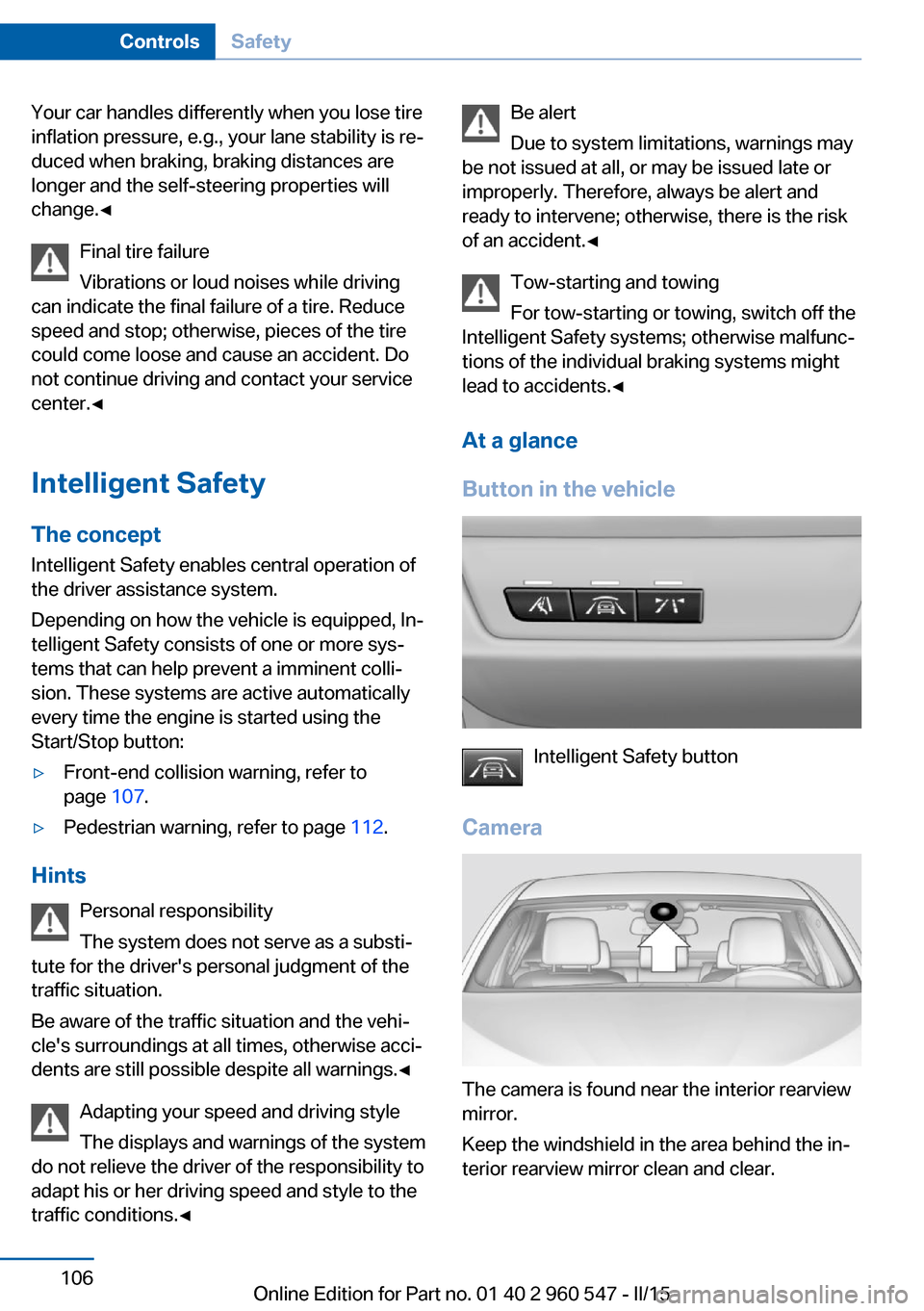
Your car handles differently when you lose tire
inflation pressure, e.g., your lane stability is re‚Äź
duced when braking, braking distances are
longer and the self-steering properties will
change.‚óÄ
Final tire failure
Vibrations or loud noises while driving
can indicate the final failure of a tire. Reduce
speed and stop; otherwise, pieces of the tire
could come loose and cause an accident. Do
not continue driving and contact your service
center.‚óÄ
Intelligent Safety
The concept Intelligent Safety enables central operation of
the driver assistance system.
Depending on how the vehicle is equipped, In‚Äź
telligent Safety consists of one or more sys‚Äź
tems that can help prevent a imminent colli‚Äź
sion. These systems are active automatically
every time the engine is started using the
Start/Stop button:‚Ė∑Front-end collision warning, refer to
page 107.‚Ė∑Pedestrian warning, refer to page 112.
Hints
Personal responsibility
The system does not serve as a substi‚Äź
tute for the driver's personal judgment of the
traffic situation.
Be aware of the traffic situation and the vehi‚Äź
cle's surroundings at all times, otherwise acci‚Äź
dents are still possible despite all warnings.‚óÄ
Adapting your speed and driving style
The displays and warnings of the system
do not relieve the driver of the responsibility to
adapt his or her driving speed and style to the
traffic conditions.‚óÄ
Be alert
Due to system limitations, warnings may
be not issued at all, or may be issued late or
improperly. Therefore, always be alert and
ready to intervene; otherwise, there is the risk
of an accident.‚óÄ
Tow-starting and towing
For tow-starting or towing, switch off the
Intelligent Safety systems; otherwise malfunc‚Äź
tions of the individual braking systems might
lead to accidents.‚óÄ
At a glance
Button in the vehicle
Intelligent Safety button
Camera
The camera is found near the interior rearview
mirror.
Keep the windshield in the area behind the in‚Äź
terior rearview mirror clean and clear.
Seite 106ControlsSafety106
Online Edition for Part no. 01 40 2 960 547 - II/15
Page 114 of 247
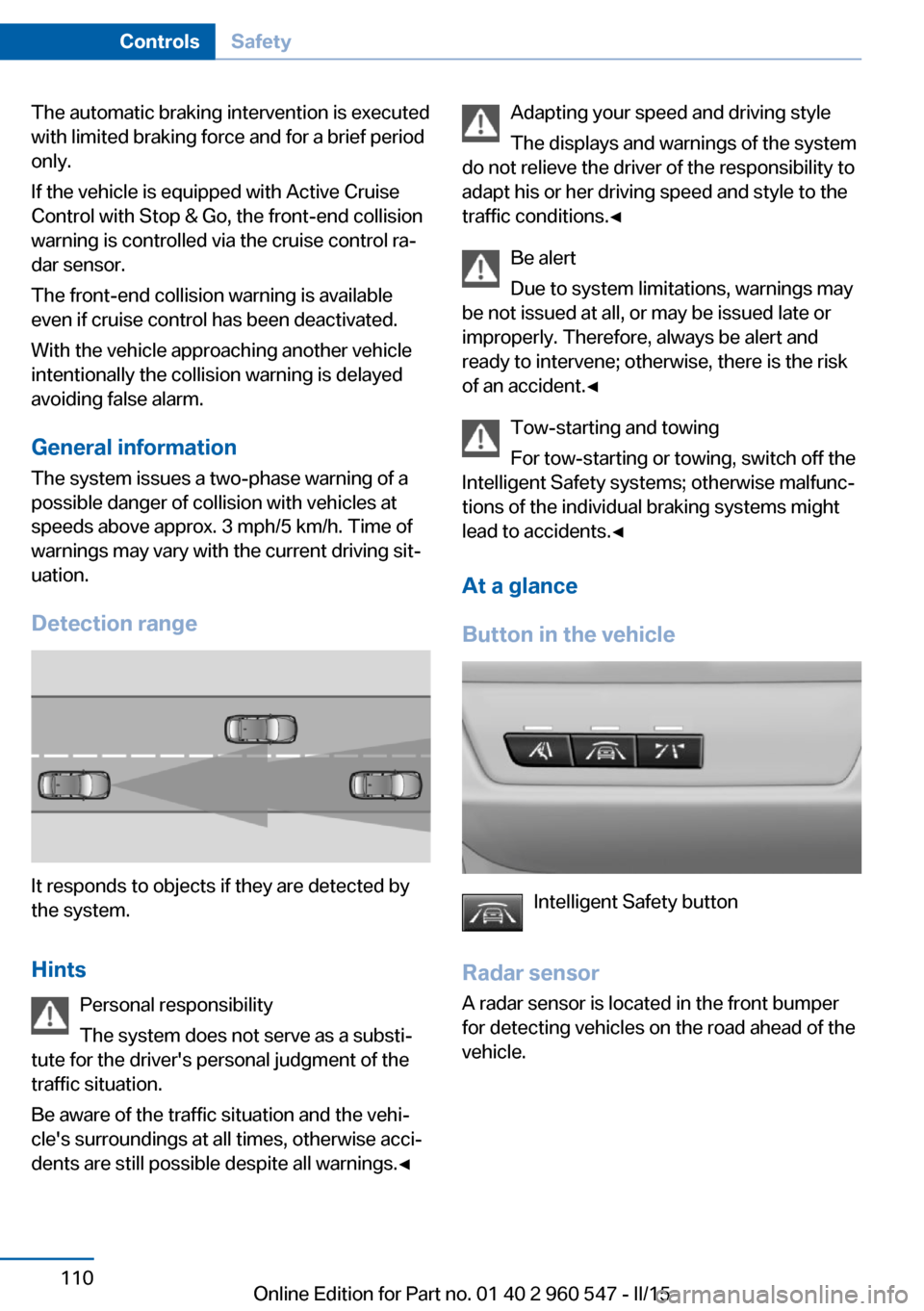
The automatic braking intervention is executed
with limited braking force and for a brief period
only.
If the vehicle is equipped with Active Cruise
Control with Stop & Go, the front-end collision
warning is controlled via the cruise control ra‚Äź
dar sensor.
The front-end collision warning is available
even if cruise control has been deactivated.
With the vehicle approaching another vehicle
intentionally the collision warning is delayed
avoiding false alarm.
General information
The system issues a two-phase warning of a
possible danger of collision with vehicles at
speeds above approx. 3 mph/5 km/h. Time of
warnings may vary with the current driving sit‚Äź
uation.
Detection range
It responds to objects if they are detected by
the system.
Hints Personal responsibility
The system does not serve as a substi‚Äź
tute for the driver's personal judgment of the
traffic situation.
Be aware of the traffic situation and the vehi‚Äź
cle's surroundings at all times, otherwise acci‚Äź
dents are still possible despite all warnings.‚óÄ
Adapting your speed and driving style
The displays and warnings of the system
do not relieve the driver of the responsibility to
adapt his or her driving speed and style to the
traffic conditions.‚óÄ
Be alert
Due to system limitations, warnings may
be not issued at all, or may be issued late or
improperly. Therefore, always be alert and
ready to intervene; otherwise, there is the risk
of an accident.‚óÄ
Tow-starting and towing
For tow-starting or towing, switch off the
Intelligent Safety systems; otherwise malfunc‚Äź
tions of the individual braking systems might
lead to accidents.‚óÄ
At a glance
Button in the vehicle
Intelligent Safety button
Radar sensor
A radar sensor is located in the front bumper
for detecting vehicles on the road ahead of the
vehicle.
Seite 110ControlsSafety110
Online Edition for Part no. 01 40 2 960 547 - II/15
Page 118 of 247
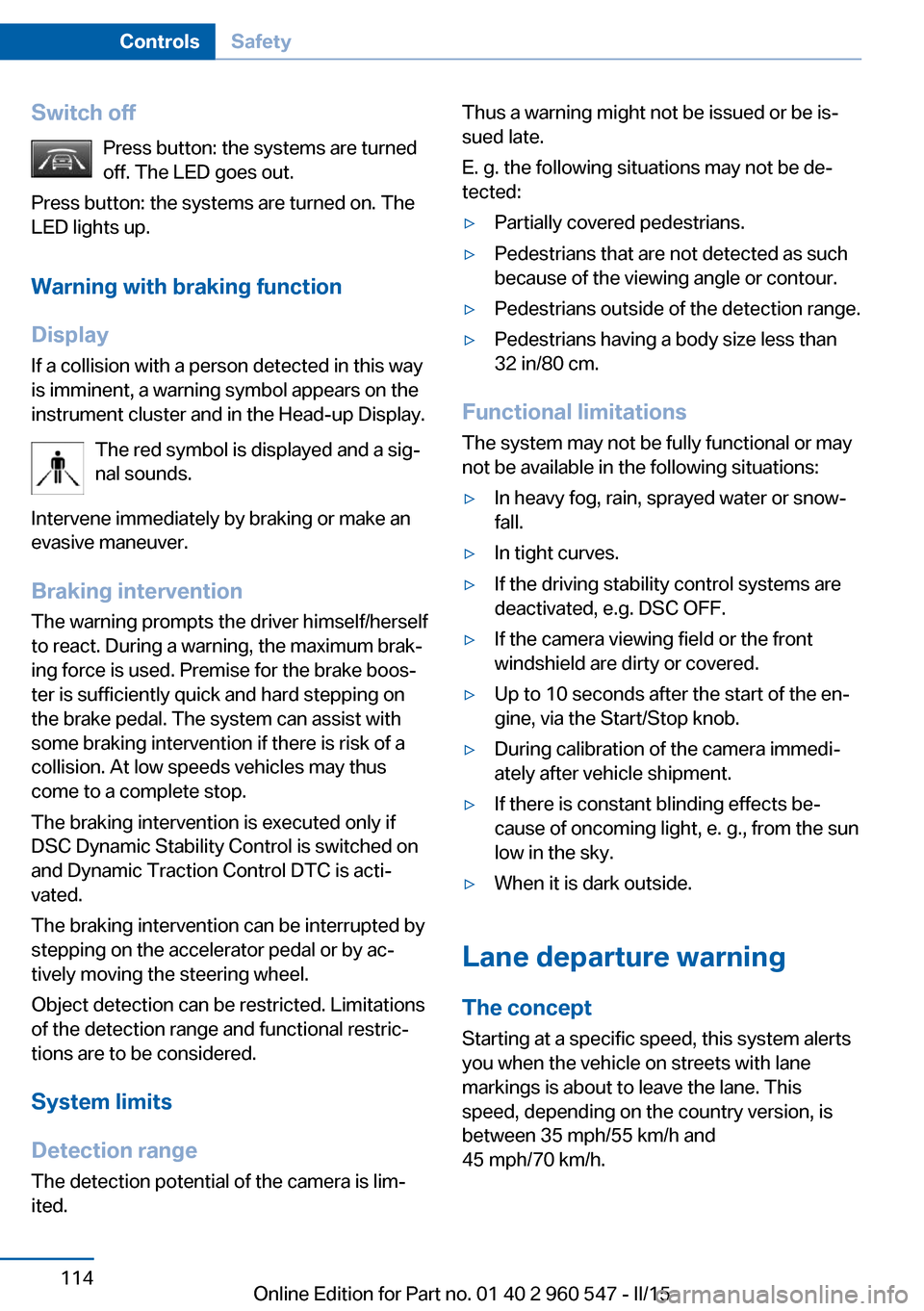
Switch offPress button: the systems are turned
off. The LED goes out.
Press button: the systems are turned on. The
LED lights up.
Warning with braking function
Display
If a collision with a person detected in this way
is imminent, a warning symbol appears on the
instrument cluster and in the Head-up Display.
The red symbol is displayed and a sig‚Äź
nal sounds.
Intervene immediately by braking or make an
evasive maneuver.
Braking intervention
The warning prompts the driver himself/herself
to react. During a warning, the maximum brak‚Äź
ing force is used. Premise for the brake boos‚Äź
ter is sufficiently quick and hard stepping on
the brake pedal. The system can assist with
some braking intervention if there is risk of a
collision. At low speeds vehicles may thus
come to a complete stop.
The braking intervention is executed only if
DSC Dynamic Stability Control is switched on
and Dynamic Traction Control DTC is acti‚Äź
vated.
The braking intervention can be interrupted by
stepping on the accelerator pedal or by ac‚Äź
tively moving the steering wheel.
Object detection can be restricted. Limitations
of the detection range and functional restric‚Äź
tions are to be considered.
System limits
Detection range
The detection potential of the camera is lim‚Äź
ited.Thus a warning might not be issued or be is‚Äź
sued late.
E. g. the following situations may not be de‚Äź
tected:‚Ė∑Partially covered pedestrians.‚Ė∑Pedestrians that are not detected as such
because of the viewing angle or contour.‚Ė∑Pedestrians outside of the detection range.‚Ė∑Pedestrians having a body size less than
32 in/80 cm.
Functional limitations
The system may not be fully functional or may
not be available in the following situations:
‚Ė∑In heavy fog, rain, sprayed water or snow‚Äź
fall.‚Ė∑In tight curves.‚Ė∑If the driving stability control systems are
deactivated, e.g. DSC OFF.‚Ė∑If the camera viewing field or the front
windshield are dirty or covered.‚Ė∑Up to 10 seconds after the start of the en‚Äź
gine, via the Start/Stop knob.‚Ė∑During calibration of the camera immedi‚Äź
ately after vehicle shipment.‚Ė∑If there is constant blinding effects be‚Äź
cause of oncoming light, e. g., from the sun
low in the sky.‚Ė∑When it is dark outside.
Lane departure warning
The concept Starting at a specific speed, this system alerts
you when the vehicle on streets with lane
markings is about to leave the lane. This
speed, depending on the country version, is
between 35 mph/55 km/h and
45 mph/70 km/h.
Seite 114ControlsSafety114
Online Edition for Part no. 01 40 2 960 547 - II/15
Page 123 of 247
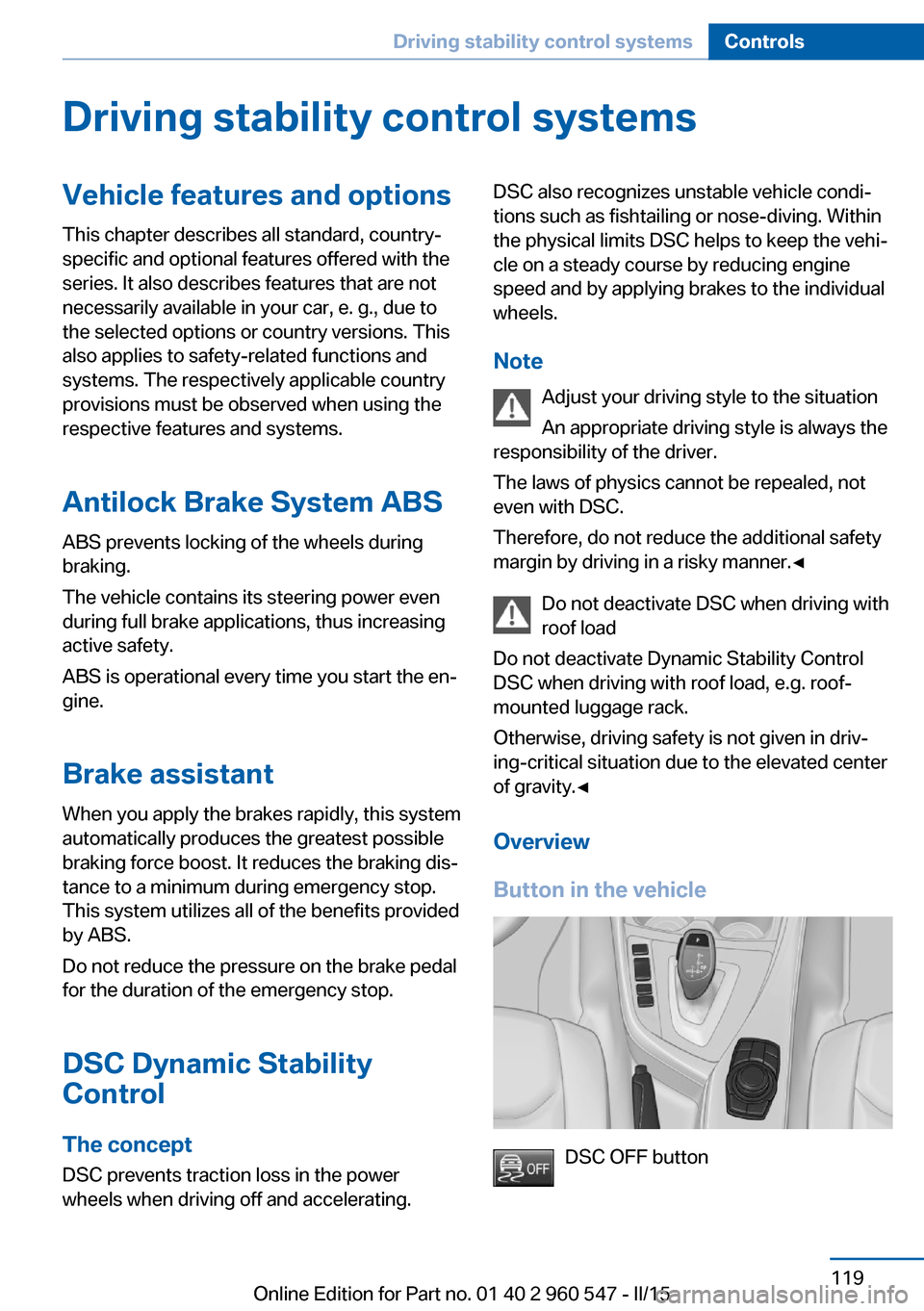
Driving stability control systemsVehicle features and optionsThis chapter describes all standard, country-
specific and optional features offered with the
series. It also describes features that are not
necessarily available in your car, e. g., due to
the selected options or country versions. This
also applies to safety-related functions and
systems. The respectively applicable country
provisions must be observed when using the
respective features and systems.
Antilock Brake System ABS ABS prevents locking of the wheels during
braking.
The vehicle contains its steering power even
during full brake applications, thus increasing
active safety.
ABS is operational every time you start the en‚Äź
gine.
Brake assistant When you apply the brakes rapidly, this system
automatically produces the greatest possible
braking force boost. It reduces the braking dis‚Äź
tance to a minimum during emergency stop.
This system utilizes all of the benefits provided
by ABS.
Do not reduce the pressure on the brake pedal
for the duration of the emergency stop.
DSC Dynamic Stability
Control
The concept DSC prevents traction loss in the power
wheels when driving off and accelerating.DSC also recognizes unstable vehicle condi‚Äź
tions such as fishtailing or nose-diving. Within
the physical limits DSC helps to keep the vehi‚Äź
cle on a steady course by reducing engine
speed and by applying brakes to the individual
wheels.
Note Adjust your driving style to the situation
An appropriate driving style is always the
responsibility of the driver.
The laws of physics cannot be repealed, not
even with DSC.
Therefore, do not reduce the additional safety
margin by driving in a risky manner.‚óÄ
Do not deactivate DSC when driving with
roof load
Do not deactivate Dynamic Stability Control DSC when driving with roof load, e.g. roof-
mounted luggage rack.
Otherwise, driving safety is not given in driv‚Äź
ing-critical situation due to the elevated center
of gravity.‚óÄ
Overview
Button in the vehicle
DSC OFF button
Seite 119Driving stability control systemsControls119
Online Edition for Part no. 01 40 2 960 547 - II/15
Page 145 of 247
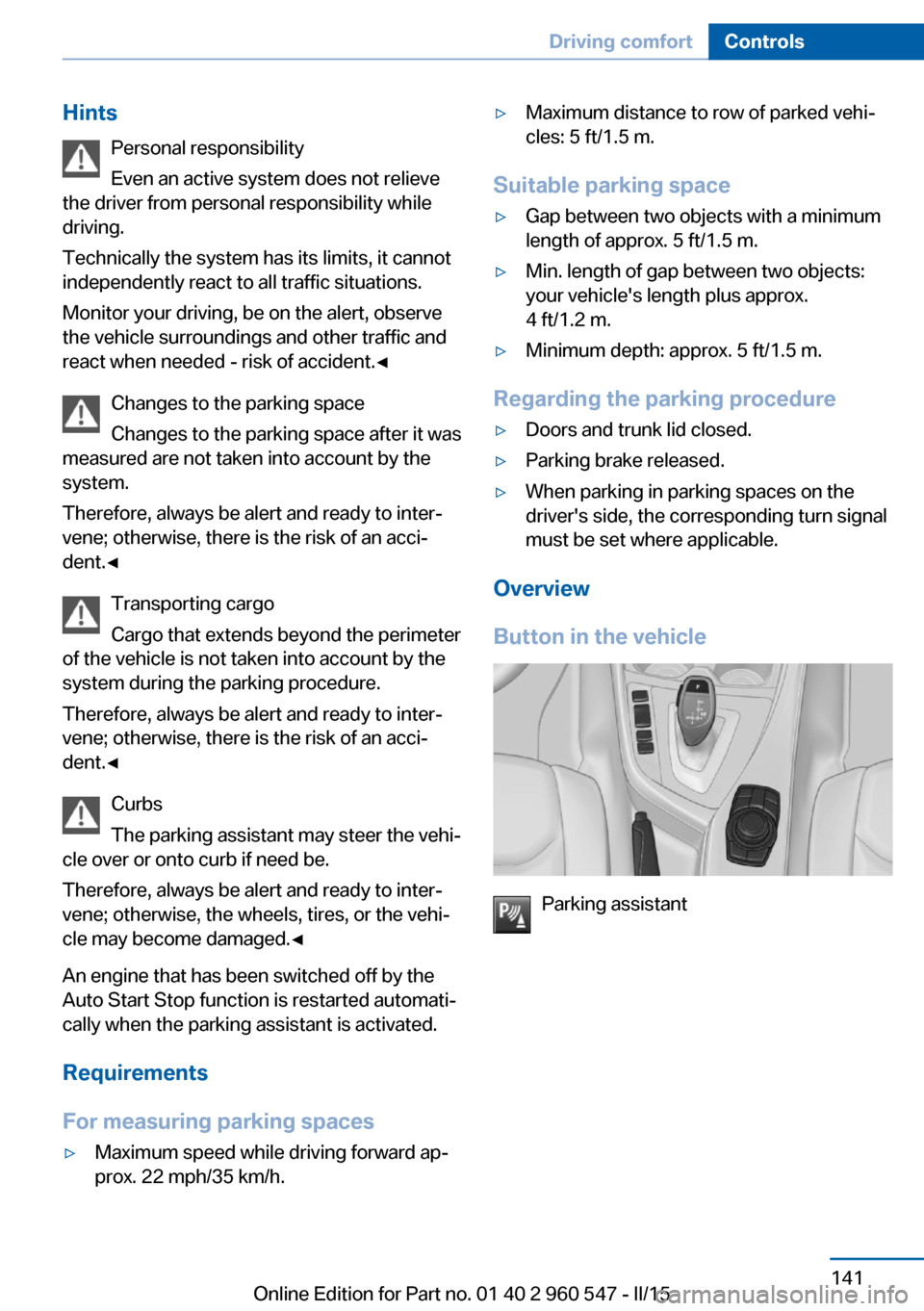
HintsPersonal responsibility
Even an active system does not relieve
the driver from personal responsibility while
driving.
Technically the system has its limits, it cannot
independently react to all traffic situations.
Monitor your driving, be on the alert, observe
the vehicle surroundings and other traffic and
react when needed - risk of accident.‚óÄ
Changes to the parking space
Changes to the parking space after it was
measured are not taken into account by the system.
Therefore, always be alert and ready to inter‚Äź
vene; otherwise, there is the risk of an acci‚Äź
dent.‚óÄ
Transporting cargo
Cargo that extends beyond the perimeter
of the vehicle is not taken into account by the
system during the parking procedure.
Therefore, always be alert and ready to inter‚Äź
vene; otherwise, there is the risk of an acci‚Äź
dent.‚óÄ
Curbs
The parking assistant may steer the vehi‚Äź
cle over or onto curb if need be.
Therefore, always be alert and ready to inter‚Äź
vene; otherwise, the wheels, tires, or the vehi‚Äź
cle may become damaged.‚óÄ
An engine that has been switched off by the
Auto Start Stop function is restarted automati‚Äź
cally when the parking assistant is activated.
Requirements
For measuring parking spaces‚Ė∑Maximum speed while driving forward ap‚Äź
prox. 22 mph/35 km/h.‚Ė∑Maximum distance to row of parked vehi‚Äź
cles: 5 ft/1.5 m.
Suitable parking space
‚Ė∑Gap between two objects with a minimum
length of approx. 5 ft/1.5 m.‚Ė∑Min. length of gap between two objects:
your vehicle's length plus approx.
4 ft/1.2 m.‚Ė∑Minimum depth: approx. 5 ft/1.5 m.
Regarding the parking procedure
‚Ė∑Doors and trunk lid closed.‚Ė∑Parking brake released.‚Ė∑When parking in parking spaces on the
driver's side, the corresponding turn signal
must be set where applicable.
Overview
Button in the vehicle
Parking assistant
Seite 141Driving comfortControls141
Online Edition for Part no. 01 40 2 960 547 - II/15
Page 226 of 247
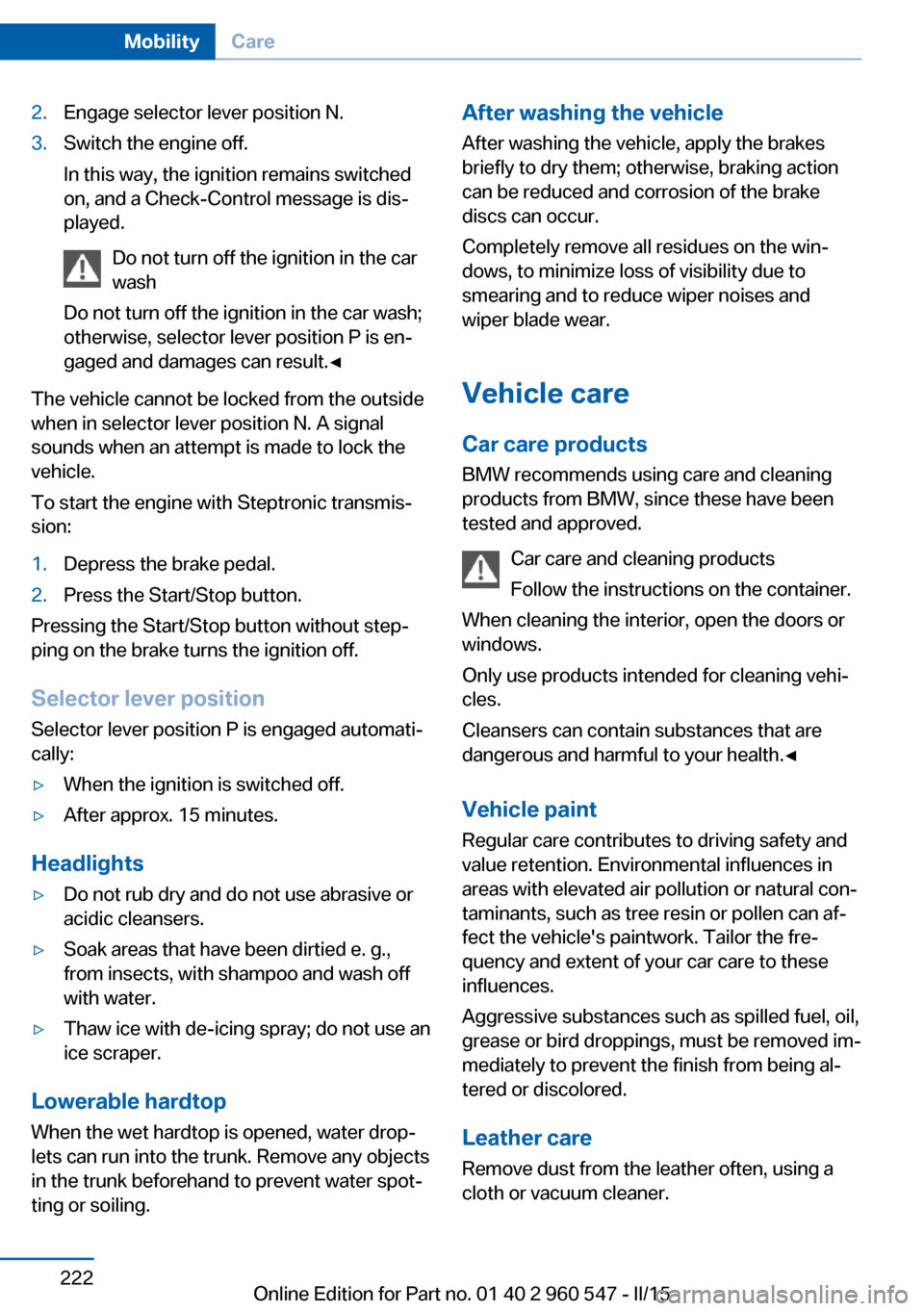
2.Engage selector lever position N.3.Switch the engine off.
In this way, the ignition remains switched
on, and a Check-Control message is dis‚Äź
played.
Do not turn off the ignition in the car
wash
Do not turn off the ignition in the car wash;
otherwise, selector lever position P is en‚Äź
gaged and damages can result.‚óÄ
The vehicle cannot be locked from the outside
when in selector lever position N. A signal
sounds when an attempt is made to lock the
vehicle.
To start the engine with Steptronic transmis‚Äź
sion:
1.Depress the brake pedal.2.Press the Start/Stop button.
Pressing the Start/Stop button without step‚Äź
ping on the brake turns the ignition off.
Selector lever positionSelector lever position P is engaged automati‚Äź
cally:
‚Ė∑When the ignition is switched off.‚Ė∑After approx. 15 minutes.
Headlights
‚Ė∑Do not rub dry and do not use abrasive or
acidic cleansers.‚Ė∑Soak areas that have been dirtied e. g.,
from insects, with shampoo and wash off
with water.‚Ė∑Thaw ice with de-icing spray; do not use an
ice scraper.
Lowerable hardtop
When the wet hardtop is opened, water drop‚Äź
lets can run into the trunk. Remove any objects
in the trunk beforehand to prevent water spot‚Äź
ting or soiling.
After washing the vehicle
After washing the vehicle, apply the brakes
briefly to dry them; otherwise, braking action
can be reduced and corrosion of the brake
discs can occur.
Completely remove all residues on the win‚Äź
dows, to minimize loss of visibility due to
smearing and to reduce wiper noises and
wiper blade wear.
Vehicle care
Car care products BMW recommends using care and cleaning
products from BMW, since these have been
tested and approved.
Car care and cleaning products
Follow the instructions on the container.
When cleaning the interior, open the doors or
windows.
Only use products intended for cleaning vehi‚Äź
cles.
Cleansers can contain substances that are
dangerous and harmful to your health.‚óÄ
Vehicle paint
Regular care contributes to driving safety and
value retention. Environmental influences in
areas with elevated air pollution or natural con‚Äź
taminants, such as tree resin or pollen can af‚Äź
fect the vehicle's paintwork. Tailor the fre‚Äź
quency and extent of your car care to these
influences.
Aggressive substances such as spilled fuel, oil,
grease or bird droppings, must be removed im‚Äź
mediately to prevent the finish from being al‚Äź
tered or discolored.
Leather care
Remove dust from the leather often, using a
cloth or vacuum cleaner.Seite 222MobilityCare222
Online Edition for Part no. 01 40 2 960 547 - II/15
Page 237 of 247
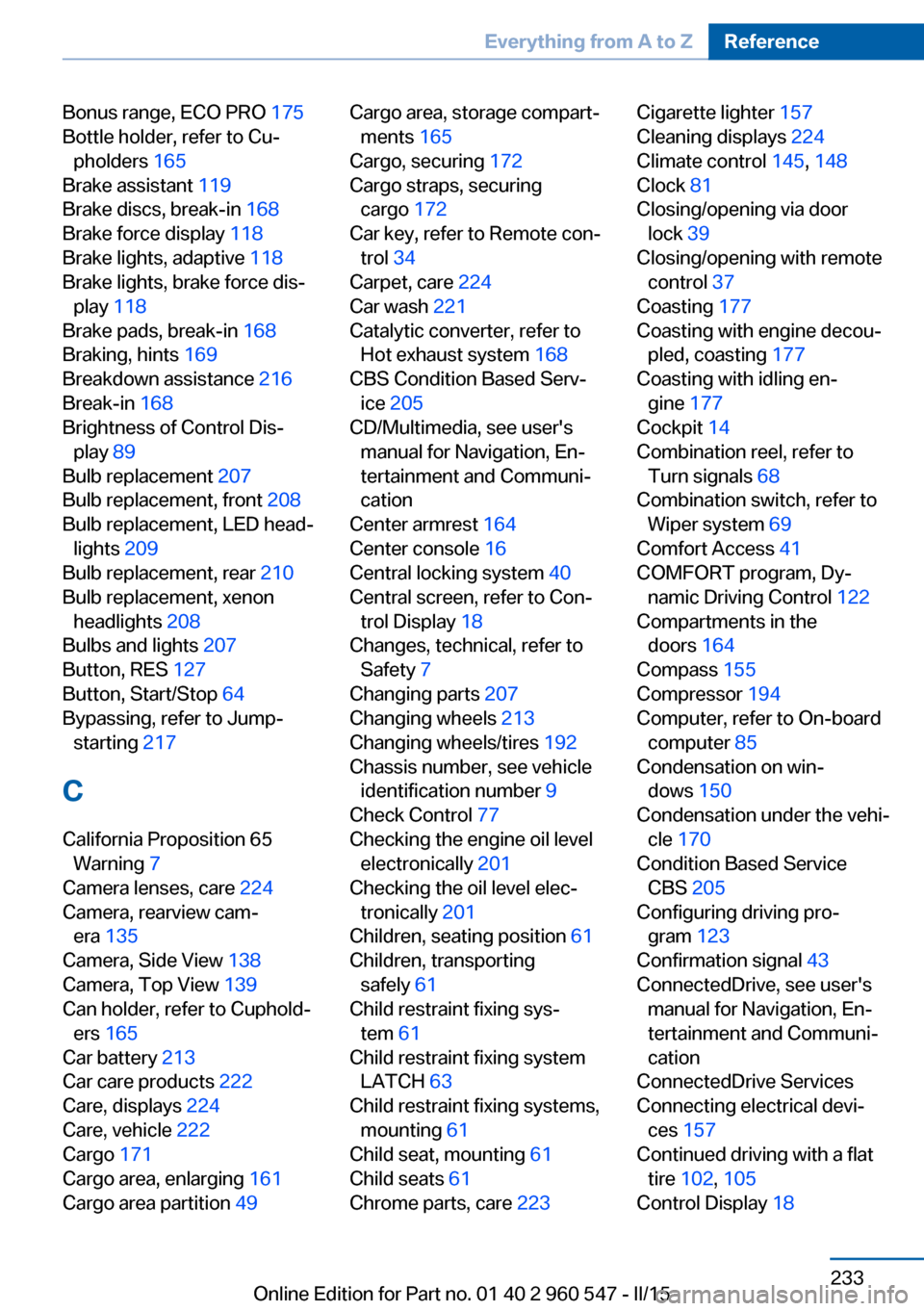
Bonus range, ECO PRO 175
Bottle holder, refer to Cu‚Äź pholders 165
Brake assistant 119
Brake discs, break-in 168
Brake force display 118
Brake lights, adaptive 118
Brake lights, brake force dis‚Äź play 118
Brake pads, break-in 168
Braking, hints 169
Breakdown assistance 216
Break-in 168
Brightness of Control Dis‚Äź play 89
Bulb replacement 207
Bulb replacement, front 208
Bulb replacement, LED head‚Äź lights 209
Bulb replacement, rear 210
Bulb replacement, xenon headlights 208
Bulbs and lights 207
Button, RES 127
Button, Start/Stop 64
Bypassing, refer to Jump- starting 217
C
California Proposition 65 Warning 7
Camera lenses, care 224
Camera, rearview cam‚Äź era 135
Camera, Side View 138
Camera, Top View 139
Can holder, refer to Cuphold‚Äź ers 165
Car battery 213
Car care products 222
Care, displays 224
Care, vehicle 222
Cargo 171
Cargo area, enlarging 161
Cargo area partition 49 Cargo area, storage compart‚Äź
ments 165
Cargo, securing 172
Cargo straps, securing cargo 172
Car key, refer to Remote con‚Äź trol 34
Carpet, care 224
Car wash 221
Catalytic converter, refer to Hot exhaust system 168
CBS Condition Based Serv‚Äź ice 205
CD/Multimedia, see user's manual for Navigation, En‚Äź
tertainment and Communi‚Äź
cation
Center armrest 164
Center console 16
Central locking system 40
Central screen, refer to Con‚Äź trol Display 18
Changes, technical, refer to Safety 7
Changing parts 207
Changing wheels 213
Changing wheels/tires 192
Chassis number, see vehicle identification number 9
Check Control 77
Checking the engine oil level electronically 201
Checking the oil level elec‚Äź tronically 201
Children, seating position 61
Children, transporting safely 61
Child restraint fixing sys‚Äź tem 61
Child restraint fixing system LATCH 63
Child restraint fixing systems, mounting 61
Child seat, mounting 61
Child seats 61
Chrome parts, care 223 Cigarette lighter 157
Cleaning displays 224
Climate control 145, 148
Clock 81
Closing/opening via door lock 39
Closing/opening with remote control 37
Coasting 177
Coasting with engine decou‚Äź pled, coasting 177
Coasting with idling en‚Äź gine 177
Cockpit 14
Combination reel, refer to Turn signals 68
Combination switch, refer to Wiper system 69
Comfort Access 41
COMFORT program, Dy‚Äź namic Driving Control 122
Compartments in the doors 164
Compass 155
Compressor 194
Computer, refer to On-board computer 85
Condensation on win‚Äź dows 150
Condensation under the vehi‚Äź cle 170
Condition Based Service CBS 205
Configuring driving pro‚Äź gram 123
Confirmation signal 43
ConnectedDrive, see user's manual for Navigation, En‚Äź
tertainment and Communi‚Äź
cation
ConnectedDrive Services
Connecting electrical devi‚Äź ces 157
Continued driving with a flat tire 102 , 105
Control Display 18 Seite 233Everything from A to ZReference233
Online Edition for Part no. 01 40 2 960 547 - II/15
Page 243 of 247
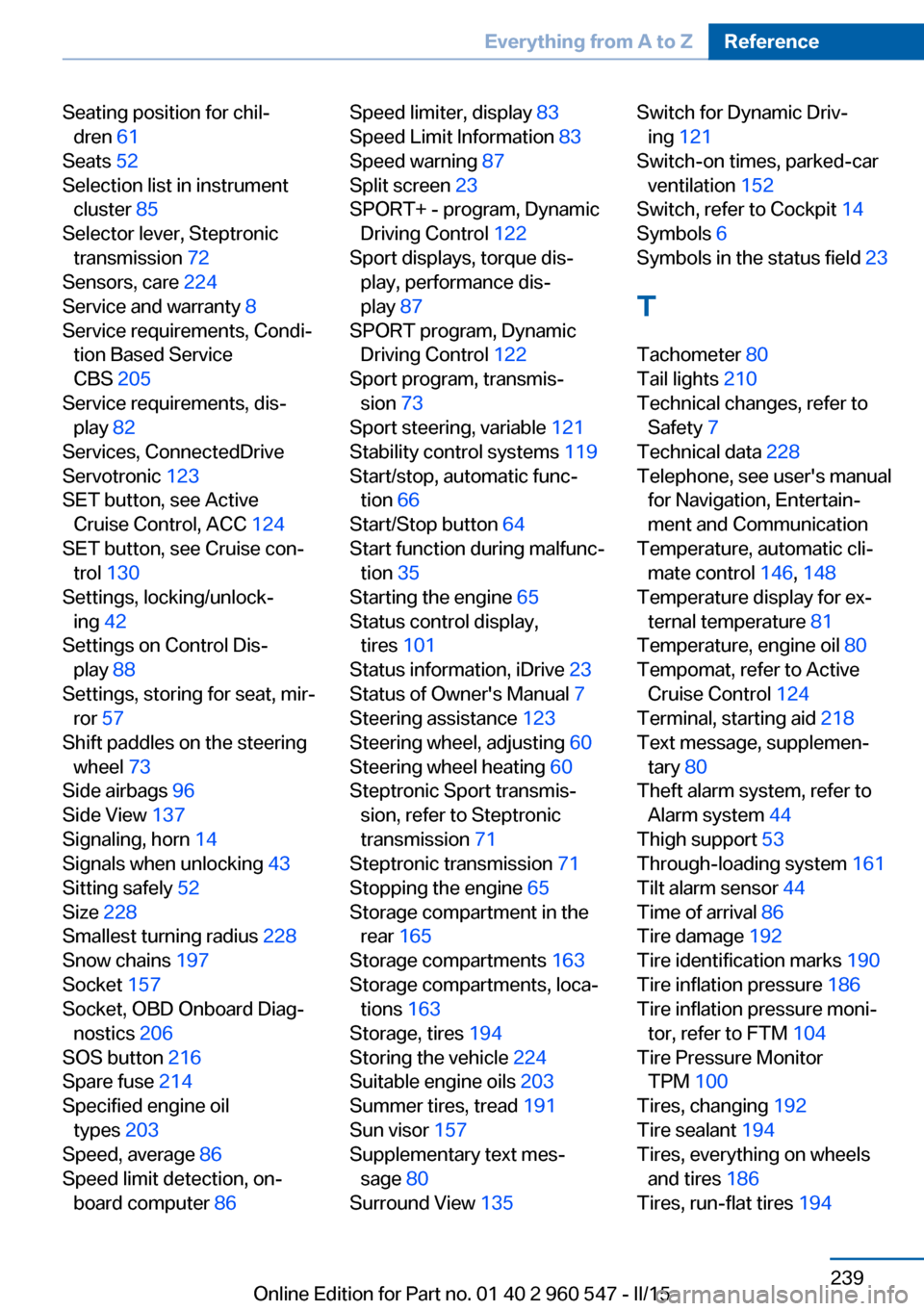
Seating position for chil‚Äźdren 61
Seats 52
Selection list in instrument cluster 85
Selector lever, Steptronic transmission 72
Sensors, care 224
Service and warranty 8
Service requirements, Condi‚Äź tion Based Service
CBS 205
Service requirements, dis‚Äź play 82
Services, ConnectedDrive
Servotronic 123
SET button, see Active Cruise Control, ACC 124
SET button, see Cruise con‚Äź trol 130
Settings, locking/unlock‚Äź ing 42
Settings on Control Dis‚Äź play 88
Settings, storing for seat, mir‚Äź ror 57
Shift paddles on the steering wheel 73
Side airbags 96
Side View 137
Signaling, horn 14
Signals when unlocking 43
Sitting safely 52
Size 228
Smallest turning radius 228
Snow chains 197
Socket 157
Socket, OBD Onboard Diag‚Äź nostics 206
SOS button 216
Spare fuse 214
Specified engine oil types 203
Speed, average 86
Speed limit detection, on- board computer 86 Speed limiter, display 83
Speed Limit Information 83
Speed warning 87
Split screen 23
SPORT+ - program, Dynamic Driving Control 122
Sport displays, torque dis‚Äź play, performance dis‚Äź
play 87
SPORT program, Dynamic Driving Control 122
Sport program, transmis‚Äź sion 73
Sport steering, variable 121
Stability control systems 119
Start/stop, automatic func‚Äź tion 66
Start/Stop button 64
Start function during malfunc‚Äź tion 35
Starting the engine 65
Status control display, tires 101
Status information, iDrive 23
Status of Owner's Manual 7
Steering assistance 123
Steering wheel, adjusting 60
Steering wheel heating 60
Steptronic Sport transmis‚Äź sion, refer to Steptronic
transmission 71
Steptronic transmission 71
Stopping the engine 65
Storage compartment in the rear 165
Storage compartments 163
Storage compartments, loca‚Äź tions 163
Storage, tires 194
Storing the vehicle 224
Suitable engine oils 203
Summer tires, tread 191
Sun visor 157
Supplementary text mes‚Äź sage 80
Surround View 135 Switch for Dynamic Driv‚Äź
ing 121
Switch-on times, parked-car ventilation 152
Switch, refer to Cockpit 14
Symbols 6
Symbols in the status field 23
T Tachometer 80
Tail lights 210
Technical changes, refer to Safety 7
Technical data 228
Telephone, see user's manual for Navigation, Entertain‚Äź
ment and Communication
Temperature, automatic cli‚Äź mate control 146, 148
Temperature display for ex‚Äź ternal temperature 81
Temperature, engine oil 80
Tempomat, refer to Active Cruise Control 124
Terminal, starting aid 218
Text message, supplemen‚Äź tary 80
Theft alarm system, refer to Alarm system 44
Thigh support 53
Through-loading system 161
Tilt alarm sensor 44
Time of arrival 86
Tire damage 192
Tire identification marks 190
Tire inflation pressure 186
Tire inflation pressure moni‚Äź tor, refer to FTM 104
Tire Pressure Monitor TPM 100
Tires, changing 192
Tire sealant 194
Tires, everything on wheels and tires 186
Tires, run-flat tires 194 Seite 239Everything from A to ZReference239
Online Edition for Part no. 01 40 2 960 547 - II/15